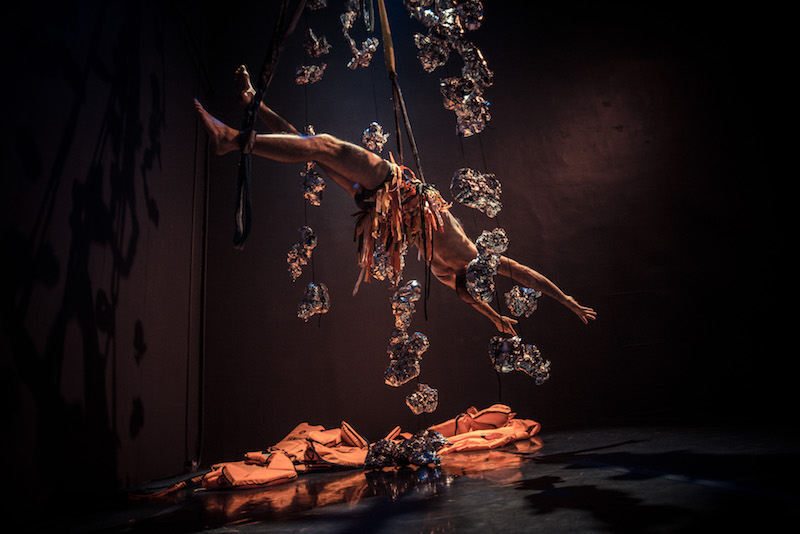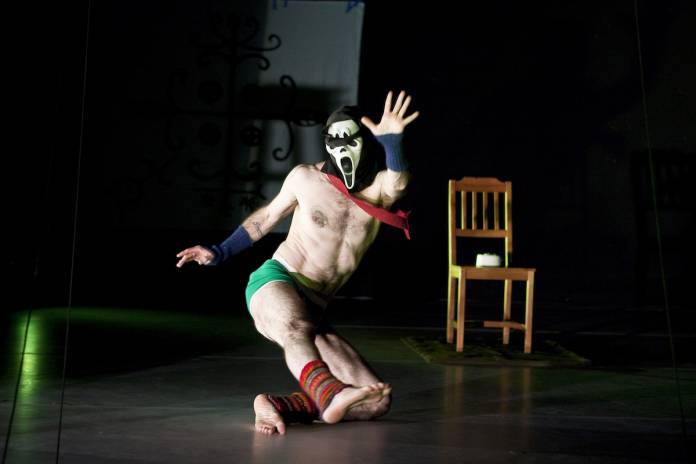DANCE/PERFORMANCE A pagan drag queen Green Man, sporting a maypole-ribbon corset and tiny Speedo, hopping about madly on stilts? A ferocious clown satire of the refugee crisis, with lifejackets from Lesbos as props? A prison-hooded stuffed bear being whipped onstage? An audience enthusiastically chanting, “Everything is fucked!”?
Renowned SF choreographer and performance artist Keith Hennessy keeps pushing buttons and expanding the borders of art, queering everything in sight while applying the twin traditions of art happenings and surrealist provocation to comment, up to the minute, on politics and identity.
The next two weekends bring a fantastic chance to see how much Hennessy’s art—or really, the context around it, since he’s always held a singular, pluralist vision—has changed in the 10 years since he’s gone from enfant terrible to éminence grise of queer dance performance. A new work that aims to engulf the viewer/participant in a cascade of hot-topic political and personal concerns, “Sink,” plays at the Joe Goode Annex Fri/1 and Sat/2. The next weekend, Thu/7-Sat/9, Hennessy performs his decade-old, now canonical “Crotch” at The Lab.
Both pieces are typical Hennessian wild rides, bursting with vibrant ideas, crazy costumes, emotionally intimate statements, history lessons, audience participation, profound movements, and radical inclusivity, as refracted through Hennessy’s highly personal concerns. But they also reflect how much art, and society, has changed since being an openly queer man disgorging colorful themes and radical acts on stage was a big, new deal. I spoke with Hennessy about the shows, and how the conversation around his work has shifted.
48 HILLS You’ve been performing “Crotch” pretty regularly for 10 years now, with its central theme of a kind of “activation” of the work of German polymath artist Joseph Beuys, accompanied by intimate queer spectacle. How has the piece evolved over that time?
KEITH HENNESSY The biggest thing is the change in how the work is received, and also what it means to me emotionally. When I made “Crotch,” I never imagined that the piece would get a lot of attention. But somehow this quiet little piece turned into the most traveled, most celebrated work in my entire career. In 2009, the piece won a New York Bessie, and my friend turned to me and said, “Girl, you’re going to be performing this piece for the rest of your life now.” I’m not against that but it’s not like a play, it’s a performance piece. Performance art doesn’t “live” in that sense. It generally comes out of a moment, it doesn’t usually endure. But somehow “Crotch” has become my “Fire and Rain.” James Taylor had this heartbreak moment, and he had to sing that song for his entire life. Luckily, it’s actually a beautiful song, and so it keeps on working. (Laughs)
So one of the things that happened to “Crotch”—I wouldn’t say that I’m cold about it now, but it used to make me cry. it’s still makes audiences cry, and I would cry performing it. That doesn’t happen anymore. I don’t approach it now quite like I’m an actor, but I do have to consciously put my self back in the contexts in which it was created. I’m having to live it emotionally the way I used to.
One of the things that happens in “Crotch” is that I give a giant lecture. And the lecture purports to give the political and philosophical historical context for the work of the influential German artist Joseph Beuys. Ten years ago, Beuys was of course known, had books published about him, etc. But he wasn’t nearly as well known as he is now. The entire genre now of what’s called social practice, and dfferent versions of the way that people are thinking through relational aesthetics and public art, all have roots in Joseph Beuys and his notion of sicla sculpture. So the reception of a work on Beuys has really changed. He’s been totally absorbed into the art school machine, everybody talks about him.
Another big thing: What we take for granted in San Francisco, like certain types of race and gender critiques, are now mainstreamed. So for me to do a work that on the surface level looks like an homage to a straight, white, iconic figure in art history is way more problematic than 10 years ago when I started it. To deliver this lecture, I try to have not just the history of Beuys but the history of white male art naratives colllapse into itself in the piece. One of the ways I resolve it is to let my own story emerge in its place. But I’m just another well-known white male artist now.
I’m a lot older, I’m in my late 50s now, and there’s ways that I show up so differently in the piece now—I went to grad school and got my Ph.D., I won a Guggenheim grant. If what you’re doing is try to detabilize the role of the white male figure, but at the same time you’re somewhat playing that role … well, so much has shifted in the past decade, and can be read and received so differently. It shifts the conversations that can come out of the piece.
For example, 10 years ago, gay marriage was an active struggle. And I made “Crotch” as a gay divorce piece. Now gay marriage has been so normalized, that when I say in the piece “My husband left me,” people are all, like, “awww.” Whereas before, it felt like a critical dig, you either laughed at how ridiculous the whole concept was, or you were like, “Ouch!” The piece was in fact written as a grief piece about a longterm relationship ending, and the risk that entailed for a gay man, but that doesn’t have the same punch now. Gay relationships are so normative now.
“Queer” has shifted so much, too. I’ve recently been invited to queer dance events and queer safe spaces, presumably as an elder, and nobody really expects a white cis-gender gay man to walk in! I’m actually representing what these places have been constructed to protect themselves from. It feels like, “I really don’t have a place here.” The shift is about identity, and it doesn’t matter that I hosted pansexual sex parties for years at my art space, or used to terrorize the boring Castro on my skateboard, or any of that. “Crotch” is called a landmark of queer performance art, but because it has no centralized racial discourse, young people today would barely recognize it as “queer” at all!

48H Knowing your work, all of those observations seem like great material to generate something new. Tell me about the new work, “Sink.”
KH Sink is brand new: It was only finished in December. I’m very racially obsessed in my work. My Ph.D. involved critical whiteness studies, and in 2015 and 2016 I was producing works for all black and queer artists. I’ve been thinking through anti-racist politics and how white people can participate in anything on that level. “Sink” comes out of all of those considerations.
At the same time, what’s similar to “Crotch” is that I didn’t ask anyone’s permission to do it. I didn’t foreground the funding of it, where as a project you have explain yourself to people for money. It was very loosely composed, and somehow I got away with being able to produce it. There was no establishment presence.
“Sink” is a very personal work and it walks directly into the question, “What are the politics that are possible during Trump regime?” Some of it literally—there’s a part where I directly address this—and some of it more expansively and deeply personally.
There is a ritualistic section at one point where I have all these different references to a pre-Christian European spirituality, but the ritual keeps collapsing into itself partly because I’m alone. I got the remnant maypole-woven ribbons from a big witches’s May Day dance. I had someone take the ribbons and make a corset for me, a corset made from 100 people’s energy dancing around the maypole, so it has this aura of the ritual in it. And I wear these giant jumping stilts, curved to bounce and made of metal, that give me a kind of stag leg. If you need a dance history reference it’s more of Nijinsky’s “Afternoon of a Faun”—it’s the man-beast, it’s the stag human. And then my head is encased in vegetation.
In one way I see it as a drag reference: I’ve replaced the high heels with stlts, the body is a corset with a little Speedo, and then instead of a wig, the wig hads taken over my entire face, so it’s mask and wig in one. You can totally see Euro-pagan trip going on, you can see the Green Man, the maypole, but they somehow don’t full meet each other and arrive. And that dance is done to music by electronic artist Marc Kate. Years ago I gave him Sylvester’s “You Make Me Feel (Mighty Real)” and I had him remix it from the point of view of someone who’s having a bad drug experience. So this song, which is hugely celebratory, starts to spin out in this hallucinogenic experience, and then starts to sink underwater and just drown and falls apart. Do you read it as a pagan dance? Do you read it as a tale of gay culture fallen into itself through excess?
There are other concerns in “Sink.” It’s really trying to connect to the exact politics of this moment. It begins with an acknowledgement of native protocol, and talking about the original people and the land, and what role non-native people might play in that. It’s almost a miniature interactive workshop. And the whole opening is a poem about the Trump era. One of the most emotional sections of the work is a 10-minute song that includes a list of places that have had mass shootings and/or other terrorist attacks, and it addresses the normalization process of mass murder.
I have to say in tribute to young people, after the murders in Orlando, you could feel an actual public grieving in the year following, in a lot of different spaces—even moreso than Vegas, even though 50 people were also killed there. I recently went to see Youthspeaks, the spoken-word poetry event involving many young people of color, and almost all the performers foregrounded their fear, anxiety, and anger about guns in schools and in America generally. It was inspiring, and made me think about how much we’re supposed to repress those raw feelings in most art and performances, not to mention in society. I wanted to get back in touch with that expressiveness.
Also in “Sink” there’s a clown section satire on the refugee crisis. The props during that section are life jackets collected by first responders on the beaches of Lesbos, discarded as the boats arrive in Greece. I take these objects that embody so much grief and fear and I treat them completely irreverently. It’s a dark drag satire, with me in a bathing suit and heels, trying to dance among them. There’s audience participation, there a whole lie about a big opera I’ve been commissioned to make with Ai Weiwei… There’s a lot addressed in the piece!
SINK
Fri/1 and Sat/2
Joe Goode Annex, SF.
Tickets and more info here.
CROTCH
Thu/7-Sat/9
The Lab, SF.
Tickets and more info here.





